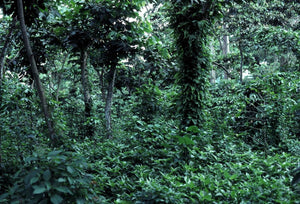The Benefits of Shade Grown Coffee: Sustainability, Ecology, Harshness, and Even Flavor

Full-sun coffee farm (source)
Like us, you may be passionate about sustainability. One of our most powerful tools as consumers is our dollar, and spending it on sustainable products is becoming more important as climate change worsens. Unfortunately, one beloved product that has caused damage to our planet is coffee. In order to meet demands from consumers, sun-tolerant coffee plants were introduced in 1972 that allowed for higher output (1). While that may seem harmless, sun grown coffee actually has an immensely negative impact on the environment. For that reason, many specialty coffee companies (including Peak State) are looking to change the narrative and return to the traditional way of growing coffee- under a canopy of trees (A.K.A “shade grown”).
There are a multitude of benefits that result from using this process to grow coffee, but the main three we will talk about in this blog post are sustainability, ecological benefits, and enhanced flavor.
Sustainability
Transitioning back to traditional shade grown coffee would result in reforestation in order to provide a natural canopy for the coffee plants on land where trees have been cut down to create full-sun coffee plantations. Not only does planting more trees result in carbon sequestration (trees capture CO2 from the atmosphere), it also provides homes for migratory birds. There has been roughly a 20% decline in migratory bird populations since 1972 due to large scale deforestation for sun grown coffee plants (1). Because of this, the Smithsonian Migratory Bird Center started calling for coffee producers to return to shade-grown coffee in 1996, and went on to create a certification for farms going the extra mile to be “bird friendly” in 1997. This certification requires coffee producers to meet very strict standards, and its goal is for coffee farms to mimic natural forest conditions (2). This certification is the most trustworthy way for consumers to know that the coffee they’re purchasing is responsibly farmed so they can do their part to combat the effects of climate change.

Sun-grown, partial shade, and shade grown coffee diagram from The Smithsonian Migratory Bird Center (source)
Another beneficial impact of shade-grown coffee is the reduction of soil erosion. This is due to the protective canopy of trees and their roots that minimize soil erosion resulting from heavy rainfall, especially in steeper landscapes from high altitude plantations (2). Leaves from trees also provide the soil with essential nutrients and help to maintain a healthy soil structure (2). In a study done in Nicaragua, it was estimated that sun-exposed coffee farms lost 2.5 times more soil that shaded farms from the same hillside (2). This soil erosion from sun-exposed farms has caused coffee farmers to have cut down more trees in other areas in order to have fresh start, but this practice is not sustainable (1). This combined with global warming trends will shrink the quantity of available and high quality coffee farming areas, so it’s imperative to transition back to shade growing practices.
Ecology
The difference between shaded coffee farms’ and sun-exposed farms’ impact on wildlife is astounding. According to a study done in Guatemala, overall bird abundance was 30% greater in shaded farms and bird diversity was 15% greater than in sun farms (2). Having a greater abundance and diversity of birds is important for the coffee plants themselves, too, because birds can drive away unwanted pests from harming coffee plants. Shade coffee farms also provide habitats for other species, including bats which help to control pests, and bees which help to pollinate coffee plants. Interestingly, the abundance of honey bees directly affects coffee fruits, with a larger abundance resulting in higher coffee fruit set and weight (2). These animals along with the natural barrier the canopy of trees provides takes away the need for chemical pesticides, which often cause more harm than good (3). Insecticides and herbicides can often end up contaminating surrounding water sources and soil (2).

Summer Tanager on a coffee plant in Colombia (source)
Flavor
In addition to sustainability and ecological benefits, growing coffee in the shade also impacts the flavor, caffeine level, acidity, and quality of the coffee beans. Since shade grown coffee matures at a slower rate than sun grown coffee, it develops more natural sugars which enhance the flavor (1). This slower pace also minimizes both the caffeine content and the acidity of the coffee (4), resulting in a smoother taste and less negative effects on the body, such as jitters and stomach aches. With how much caffeine can be in a cup of coffee, jitters are a common side effect. However, slower maturation processes from shade grown coffee combined with cooler temperatures at higher altitudes naturally lowers caffeine levels in coffee beans (5). Coffee acidity can lead to stomach aches, especially in quickly grown, sun-exposed coffee beans. Coffee with lower acidity is friendlier on the stomach, which is just another reason to switch to shade grown coffee. Lastly, the nutrients provided by the other plants, especially fruit plants, increase the quality of the coffee beans (6). Higher quality coffee beans, more often than not, taste better than lower quality beans.

It is clear that shade grown coffee is superior to sun grown coffee for multiple reasons, especially for its sustainability, ecological, and flavor benefits. Even though sun grown coffee can be mass produced to meet high demand, it’s just not worth it in the long run. Luckily, there are an increasing amount of sustainable coffee companies that are aware of this issue and are working hard to transition the coffee industry back to shade grown coffee. Currently, the U.S. market share of organic, shade grown coffee beans is about 1%, or $30 million (1). Still, in order to continue enjoying coffee for years to come, that percentage needs to increase. We can all do our part by purchasing from sustainable coffee companies who source from shaded coffee plantations, and look for Bird Friendly Coffee certification labels.
Check out Peak State’s shade grown coffees here.

